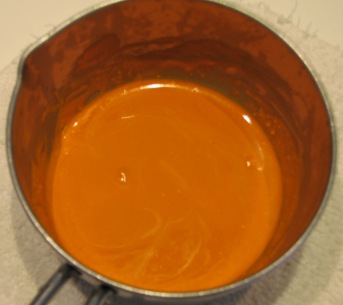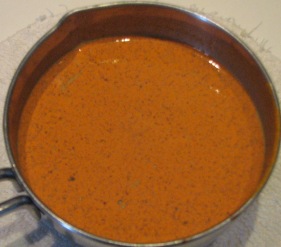A blog reader recently sent me a fascinating message concerning the bioavailability of curcumin and his own experiments with curcumin. Since I believe that it is essential for us to be aware of what happens to curcumin once we swallow it, I would like to reprint parts of his message (divided into brief chapters). Here follow a few suggestions on how to dissolve curcumin powder. Some of these methods have been discussed on previous occasions:
I verified that curcumin will not dissolve in plain water, although if curcumin is added to water and then boiled it appears to dissolve. However, upon closer examination following cooling of the mixture it turns out that the clumps of curcumin crystals from the capsule were broken up by the agitation of the water and a suspension of fine crystals or tiny clumps of crystals was formed and its color and opaqueness suggested a solution existed. But then after time the suspended particles settled out, leaving essentially clear water and curcumin solids at the bottom. No curcumin actually dissolved.
Curcumin will rapidly dissolve in ethanol (ethyl alcohol) and in glycerine, which is a sugar alcohol, edible and sweet tasting. However, these two solutions will be digested differently than curcumin dissolved in the true oils, and are not the preferred way to get curcumin, in my opinion, as will be explained later.
But it is quite easy to dissolve curcumin in various edible oils. For example, curcumin from a 900 mg capsule would readily dissolve in one teaspoon (or 4 grams) of each of the following oils, with only a small amount of mixing: omega-3 fish oil, flax seed oil (which is another omega-3 oil), olive oil, canola oil, and clarified and warmed butter.  In addition, curcumin from a 900 mg capsule would readily dissolve in one melted dark chocolate truffle, weighing 18.3 grams and containing 8 grams of fat.
In addition, curcumin from a 900 mg capsule would readily dissolve in one melted dark chocolate truffle, weighing 18.3 grams and containing 8 grams of fat.
Curcumin dissolved in the warmed butter and chocolate present some interesting possibilities in taking your curcumin. For instance, I spread the teaspoon of cooled but still softened butter/curcumin mix on a piece of toast and it was very delicious and just a little tangy. How about pancakes, French toast? Also, the melted chocolate/curcumin mix was poured into a flat saucer and hardened in the refrigerator, then cut up into small rectangles that could be saved and then later popped into the mouth and swallowed whole, without even chewing. Needless to say, the chocolate mix was very delicious while in the mouth.
All of the oils with dissolved curcumin can be readily swallowed by the teaspoonful and vary somewhat in their taste and palatability and feel in the mouth. I very much prefer the fish oil, because it is virtually tasteless and easy to swallow. I use Carlson’s Very Finest Liquid Fish Oil and buy it in 500 ml bottles, a case of 8 bottles at a time from Lucky Vitamins, Vitacost, or whoever has the best price at the time. Once opened, the bottle is kept in the refrigerator to prevent oxidation and development of a poor taste.
When my curcumin, which I buy from Swanson’s Vitamins, was mixed in all six of the above fats and other two fluids I noticed that there were tiny little residual grains of hard stuff that did not dissolve, like sand. But they could be crushed up with the back of a spoon into finer particles, which still did not dissolve. This affects the palatability somewhat when the mix is taken by the spoonful, because you feel these small granules in the mouth. This gritty stuff may be unique to the Swanson’s curcumin, which is the standard 95% curcuminoids blend of curcumin and the other two curcuminoids. But maybe that remaining 5% is stuff that the Curcuma longa plant makes that is not soluble in any of the tested oils and alcohols. But I never even noticed the gritty stuff when eating my curcumin/butter toast or chocumin chip.
My own observations: like my blog reader, I have been stumped by the sand-like grains that don’t dissolve. Since I use the C3 Complex Sabinsa curcumin, grittiness would appear to be a common feature of curcumin. I too tried crushing the gritty bits with a spoon, but soon realized that it was pointless. As my blog reader suggests, however, these grainy formations do NOT occur when warm butter is used. Dissolving curcumin in warm butter has another benefit: you can skip the double cream and use milk instead (fewer calories!), if you plan to drink the mixture.  First, dissolve the curcumin in a bit of warm butter, not much at all, then slowly add the hot chocolate milk. Photo number 1 (above) demonstrates that curcumin dissolves perfectly in butter. No gritty remains. The second photo (here on the left) shows the end result, after the addition of hot chocolate milk. Both photos are a bit out of focus, I apologize. The second one doesn’t clearly show that the dissolved curcumin sort of floats on top, similar to what happens when you add a bit of oil to a glass of water. But I assure you that that is the case. By the way, in recent days I have been putting less chocolate into the mixture, which I find more palatable, oddly enough.
First, dissolve the curcumin in a bit of warm butter, not much at all, then slowly add the hot chocolate milk. Photo number 1 (above) demonstrates that curcumin dissolves perfectly in butter. No gritty remains. The second photo (here on the left) shows the end result, after the addition of hot chocolate milk. Both photos are a bit out of focus, I apologize. The second one doesn’t clearly show that the dissolved curcumin sort of floats on top, similar to what happens when you add a bit of oil to a glass of water. But I assure you that that is the case. By the way, in recent days I have been putting less chocolate into the mixture, which I find more palatable, oddly enough.
My concern about making chocolate lozenges would be curcumin degeneration. Heated up, then cooled in the fridge would that alter the healing properties of curcumin? No idea.
As for my reader’s suggestion to spread curcumin on French toast etc., my friend Don (see the link to his blog, Myeloma Hope, on the right-hand side of my homepage) tried adding curcumin to his morning oatmeal. Well, why not? I would dissolve the curcumin in a bit of butter first, then add it to the oatmeal. Since I love oatmeal, I may try that some day.
I haven’t had time to do any blogging in the past few days. No time for any research, no time to answer e-mails (for which I apologize!) or blog comments, etc. My to-do list is getting longer and longer. YIKES! I have simply been ignoring it. 😉 I have been busy, busy, busy, but away from my computer. I have spent a lot of time with my MMA list friend (fun!) as well as preparing my classes and teaching.